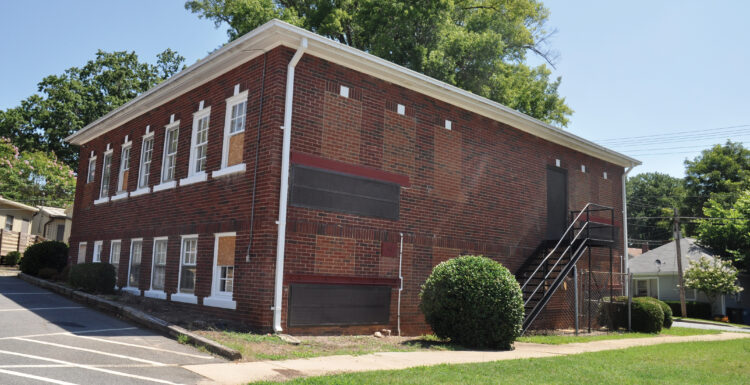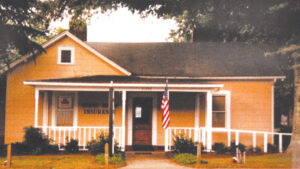
The Ag Building is located on the grounds of the original Cornelius High School | Photos courtesy Jack Conard
Dec. 13. By Mike McGinnis. Three components make up the rich history of Cornelius.
To begin with there are an abundance of stories, pictures, relics, artifacts, and history of the town of Cornelius.
Secondly, Cornelius is the home to Smithville, one of the oldest African-American communities in Mecklenburg County.
And the third historic element is the advent of Lake Norman, planned in the 1950s and filled in 1963. The lake sparked the growth of the town to the west of Interstate-77.
While a mini-museum was started in the Town Hall nearly five years ago, the town doesn’t have a place to display all of its history and to tell its story.
Interestingly enough, Cornelius is mostly made up of people who didn’t grow up in the town.
As a result, native residents such as Mayor Woody Washam feel that it’s high time to put all of that rich history into one place.
“A museum would help the people that have recently moved here and those that will continue to move to our town to have a place to go to and read about what brought us to the dance, if you will,” Washam said. “It’s important to let our school children know where we came from and how we got to be the town that we are.”
Taskforce goals
A 15-member mayoral task group, formed six months ago, is currently in the research stage of creating a historical museum for the town of Cornelius.

Members of the mayoral task group
Some members of the committee are native Cornelius residents that can help tell the story of ‘old’ Cornelius. Meanwhile, some members are key to fundraising for the project and others have a background in technology to help see the museum come to life.
While most of the committee’s progress will be noticeable in the new year, Mayor Washam says the task force is focused on finding a location for the museum.
In an effort to preserve a historic building vs. building a new structure, the committee is exploring the possibility of converting the old Agricultural Building into a historical museum.
The Ag Building, as it’s affectionately known by locals, is located on the grounds of the original Cornelius High School, which is now the site of the Cornelius Elementary School.
The building was built in the 1930s and measures 4,000 square feet. After a number of site visits by town officials, the nearly 100 year old building is seen as a good prospect for the new museum.
Cornelius looks to take a page from the town of Matthews that converted its Ag Building into a history center.
After visiting a number of similar projects in different communities, the committee is honing in on the old Ag Building as the top choice for the site of Cornelius’s museum.
Because the Charlotte-Mecklenburg School District owns the old Ag Building, the committee is having discussions on how it can gain possession of the facility.
The committee is working on gaining Historic Landmark status for the Ag Building from Mecklenburg County.
“We’re going into this thing with no money. We’ll have to raise some money,” Washam said.
An application to form a 501c3 nonprofit organization titled “Cornelius History Museum” had been filed. By year-end, the organization will be setup for people to make a donation and receive a tax write-off.
Jim Duke, a former Cornelius commissioner, is serving as the Cornelius Museum committee’s treasurer.
Big Yellow Taxi
They took all the trees,
put ‘em in a tree museum
And they charged the
people a dollar and a half just to see ‘em
[Chorus]
Don’t it always seem to go
That you don’t know what you’ve got ‘til it’s gone?
They paved paradise,
put up a parking lot
—Joni Mitchell
“We should be well on our way with the project after the first of the new year. A number of people have verbally committed to support the project financially,” Duke said. “I don’t know if we can get it done in a year. It may take two years.”
Duke says it will be important for the museum to capture what Cornelius was like before Duke Energy and the company’s efforts behind the Lake Norman Dam.
“What’s under the lake, how did The Peninsula come about and the Smithville community. It’s an amazing amount of things that have happened over the years that need to be chronicled to help people understand how we got here,” Duke said.
Fundraising
Because the old Ag building does not meet the American Disability Act (ADA) accessibility standards, along with much needed rehab and refurbishing efforts, the project is tentatively expected to cost between $1 million to $1.5 million.
Much like how the town raised $25 million for the building of the Cain Center for the Arts, the museum will be a public/private endeavor. An opening ceremony for the Cain Center is set for January 2023.
Preservation approach
While surrounding communities may have a higher profile for historical preservation efforts, the town of Cornelius is sending a signal to residents about its attempt to preserve history by way of a new museum.
For instance, historic preservation has long been a priority for the Town of Davidson. In 1989, the Historic Preservation Commission (HPC) was created, as well as the first local historic district. This local district gave the town control, through the HPC, over the design of structures built within the district. The Davidson Board of Commissioners affirmed the importance of historic preservation in their 2020 Comprehensive Plan and also more recently as one of the guiding tenets in their most recent Strategic Plan.
In Cornelius
“Preservation has always been a priority where it makes sense. We have made several designations (of historical preservation) to date such as the Pott’s Barbershop,” Washam said.
Known as Mecklenburg County’s first black owned haircut facility, Pott’s was started in the 1950s.
“If landowners want that and it makes sense to grant that, then certainly the town would work with the Mecklenburg County Historical Preservation Group to work that out,” Washam said.
When asked if the historical Doc Washam house on Catawba Avenue in Cornelius wold be preserved or torn down, town officials remained uncertain.
“I don’t think whether it will be torn down is set in stone, there are a lot of development opportunities. There is a lot of demand for that particular piece of property,” Mayor Washam said.

Historical Doc Washam house
In fact, the town board will be considering a major project for that Doc Washam property in the upcoming months, Washam said.
“It depends on whether any aspect of that project is passed,” Washam said.
For decades, Doctor Washam helped deliver most of the newborn babies in Cornelius.
Mayor Washam noted that some of the buildings around the Doc Washam house are crumbling. An effort can be made to keep some of the facades in place and shore up the buildings that are there.
“I don’t think we will be able to stop development. But, there are ways to blend historical development and new development,” Washam said.
There is no doubt that preserving the past in an exploding development environment, as is the case in the Lake Norman area, always proves to be a fine needle to thread.
Renderings for a mixed-use development project that would be built on the Doc Washam property has the historical house being torn down.
Local preservation enthusiasts are also eyeing the end result of a four-lot parcel along Catawba Avenue at School Street that was reported on the market for $1.6 million. Three of the four parcels contain turn-of-the century houses in various states of repair. The 1.4 acre, four-lot parcel is within walking distance of the Cain Center.
The old farmhouse at Alexander Farm failed to gain support for preservation from the Town of Cornelius or the Historic Preservation Committee. Though the farmhouse was torn down, the tenant house was saved after the state of North Carolina officials found it in a required survey of wetland areas.
Washam added, “There are a lot of other areas along Catawba that we are very hopeful that a lot of preservation could take place.
Commission now a committee
Mecklenburg County now operates Cornelius’s preservation commission.
Because it has the staff and resources to handle preservation efforts, the Mecklenburg County Preservation Group is taking the reins of Cornelius’s newly reconfigured Historical Preservation Committee.
The town of Cornelius’s historic preservation committee does have two members that sit on the museum task group.
“To have them on the task force helps to keep them informed and be able to suggest ideas for the new museum all over town, particularly our downtown,” Washam said.

Dan Morrill
Dan Morrill, the noted Mecklenburg County historian who consults for Preserve Mecklenburg, said he was grateful for the town’s help in preserving the tenant house on the Alexander Farm property.
Preserve Mecklenburg has also expressed its interest in seeking a preservation solution for two houses on Catawba Avenue just west of the proposed Mills Market project downtown. The six-story Mills project would preserve some of the facades on Catawba and replace the historic Doc Washam house with commercial.
“I think the Town of Cornelius must be a partner in any successful preservation efforts in Cornelius,” said Morrill.





